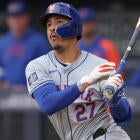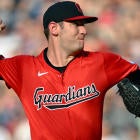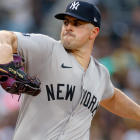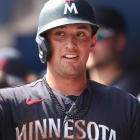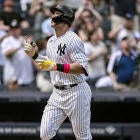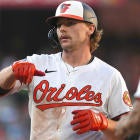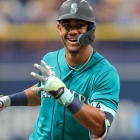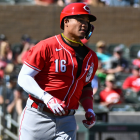Rich Gossage led or co-led the AL in saves in three different seasons and he's going to enter the Hall of Fame this summer. But of those three seasons, he averaged about 29 saves.
Last season, 18 different major league pitchers posted more than 29 saves. The times have changed and veteran Rotisserie owners realize more than ever how the closer position has evolved over the past few decades. While we happen to be talking about a large span of time, it's also true over the past few years.
There is no other position in Fantasy Baseball that is as volatile as the closer's job. Fact: Closer, or a relief pitcher in general, is the only position that can affect the saves category. No other 5x5 Rotisserie category is as exclusive to one position than saves. And the fact that saves take up 10 percent of most Rotisserie leagues makes closers a position you pretty much have to tend to.
|
ADP for Top 30 Relievers For CBSSports.com Rotisserie leagues |
|
| Round.pick | Player, Team |
| 5.03 | Jonathan Papelbon, BOS |
| 6.05 | Francisco Rodriguez, LAA |
| 6.08 | J.J. Putz, SEA |
| 6.11 | Joe Nathan, MIN |
| 7.08 | Brett Myers*, PHI |
| 8.12 | Takashi Saito, LAD |
| 9.03 | Mariano Rivera, NYY |
| 9.09 | Bobby Jenks, CHW |
| 9.11 | Billy Wagner, NYM |
| 10.03 | Jose Valverde, HOU |
| 10.07 | Francisco Cordero, CIN |
| 10.11 | Rafael Soriano, ATL |
| 11.05 | Chad Billingsley*, LAD |
| 12.09 | Manny Corpas, COL |
| 13.05 | Brad Lidge, PHI |
| 14.02 | Chad Cordero, WAS |
| 14.03 | Joba Chamberlain*, NYY |
| 14.04 | Trevor Hoffman, SD |
| 14.11 | Huston Street, OAK |
| 14.12 | Jason Isringhausen, STL |
| 15.06 | Matt Capps, PIT |
| 15.08 | Joe Borowski, CLE |
| 15.09 | Todd Jones, DET |
| 16.06 | Joakim Soria, KC |
| 17.11 | Eric Gagne, MIL |
| 18.09 | Kevin Gregg, FLA |
| 18.10 | Carlos Marmol, CHC |
| 19.02 | Jonathan Broxton, LAD |
| 19.03 | B.J. Ryan, TOR |
| 19.05 | Brian Wilson, SF |
| * | Expected to pitch in the rotation. |
Can you punt the category? Absolutely -- but you better be dead on in the other nine categories if you want to compete for a championship. If 90 Rotisserie points wins a league, you'll need to score at least 10 points (ranking third) in the other nine categories -- and that's much more difficult than just trying to compete in the saves category.
Closer History 101
Gossage enters the Hall of Fame just 17th on the all-time saves list with a total of 310 successful saves. There are six active players that have more saves than him, and there are at least two more (Todd Jones and Jason Isringhausen) that could realistically pass him up this season.
But of Gossage's 310 saves, he pitched more than one inning in 193 of them. Actually, he has 125 saves of two or more innings. Closers nowadays are usually working one-inning -- and in some cases, less than one inning -- save opportunities. The position has become specialized more than ever, and Fantasy owners realize that there aren't many closers working in non-save situations as much as they once were.
What that means is that closers have very little room to fail unlike past seasons. When they come in the game, they normally can't give up a homer and not affect more than just their ERA. They are now losing save opportunities for your Fantasy team. And not just the save in that instancce, but possibly future save chances if they do it too many times.
Looking over the past eight seasons, there hasn't been much change in the closer position and saves category. There were, on average, 1212 saves recorded over those eight seasons, with a high of 1254 (2005) to a low of 1178 (2000). That's just a difference of 76 total saves, or about two per team. Not enough to make you change the way you draft.
Of the 133 relievers that recorded a save last season, only 32 were drafted among the top 276 players in CBSSports.com's average draft ranking (12 teams, 23-player rosters). Actually, there were 11 closers that had 10 or more saves that went undrafted in most leagues: Cincinnati's David Weathers (33), Florida's Kevin Gregg (32) and Jeremy Accardo (30) of the Blue Jays.
You can safely wait on closers and I'm about to give you a number of other reasons to back that up.
Good closers on bad teams
It has sometimes been said that you should avoid taking closers from bad major league teams. Is that a solid rule to live by? Let's take a closer look.
Looking at the 40 playoff teams and the 40 worst teams of the past five seasons, we notice a few things. Of the 40 playoff teams, 26 were ranked in the top 10 in saves in their respective seasons. But four of those 40 teams were also ranked among the lowest 10 teams in total saves in that span. That number includes the Yankees, who had 35 total saves in '07, which ranked 25th in the majors -- the lowest ranking of any of the playoff teams since 2003.
Only two of the 40 worst teams in the past five years landed in the top 10 saves in a season. And 26 of the 40 worst teams were among the bottom 10, which is in direct correlation to the 40 playoff teams in the top 10 in saves.
It stands to reason that the teams with the most wins will have the most saves, and the teams with the fewest wins will have the fewest saves. But what's important to note is that individual closers on bad teams can still be decent picks.
For instance, last season, the White Sox won only 72 games, which ranked them 24th in the majors. But only four players had mores saves than Bobby Jenks' 40 in '07. In 2006, the Brewers had the fourth-worst record in the NL, but both Francisco Cordero and Derrick Turnbow were able to record at least 20 saves apiece. In 2005, Danys Baez had 41 saves for the 67-win Devil Rays and Eddie Guardado had 36 saves for the 69-win Mariners.
The point to make is not to avoid all closers just because they are on bad teams, but obviously the success rate is much smaller on teams that win 20 fewer games than some of the top teams. Good closers on bad teams without much competition for their role seems to be the best bet. If you figure a team that loses 90 games a year, their wins are usually spread apart, so a closer isn't going to get overworked. And since they are a poor team, it's likely that any chances they have at wins are by just a run or two, and blowouts in their favor are probably rare, which gives a closer more chances than some better teams that blow teams out (Yankees in '07).
A few closers that fall into this category include: Chad Cordero, WAS; Francisco Cordero, CIN and Joakim Soria, KC. This also assumes that Jenks' White Sox team will be good, after a number of offseason additions.
Safe picks with veterans
|
ADP for Top 30 Relievers For CBSSports.com H2H leagues |
|
| Round.pick | Player, Team |
| 5.09 | Brett Myers*, PHI |
| 5.12 | Jonathan Papelbon, BOS |
| 6.01 | Francisco Rodriguez, LAA |
| 6.03 | J.J. Putz, SEA |
| 6.10 | Mariano Rivera, NYY |
| 7.09 | Joe Nathan, MIN |
| 8.03 | Chad Billingsley*, LAD |
| 8.04 | Jose Valverde, HOU |
| 8.06 | Huston Street, OAK |
| 8.07 | Joba Chamberlain*, NYY |
| 8.08 | Takashi Saito, LAD |
| 8.09 | Bobby Jenks, CHW |
| 8.11 | Billy Wagner, NYM |
| 9.08 | Trevor Hoffman, SD |
| 9.11 | Jason Isringhausen, STL |
| 10.11 | Rafael Soriano, ATL |
| 11.01 | Francisco Cordero, CIN |
| 11.05 | Chad Cordero, WAS |
| 11.08 | Todd Jones, DET |
| 12.06 | Joe Borowski, CLE |
| 12.09 | Shaun Marcum*, TOR |
| 13.06 | Brad Lidge, PHI |
| 14.03 | Manny Corpas, COL |
| 15.03 | Zack Greinke*, KC |
| 16.10 | Kevin Gregg, FLA |
| 17.06 | Eric Gagne, MIL |
| 17.11 | Brian Wilson, SF |
| 18.02 | Joakim Soria, KC |
| 19.01 | Matt Capps, PIT |
| 20.12 | Carlos Marmol, CHC |
| * | Expected to pitch in the rotation. |
For those wondering why you don't spend a high draft pick on a closer -- that's one of the reasons. It's tough for a pitcher to remain at such a high level -- and it's tough for a team to stay at such a high level -- for that long.
Does age have anything to do with it? Looking at last year's top 10 in saves, only Chad Cordero and K-Rod entered the season 25 or younger. But it doesn't seem like there's a cap on the other end either, since there were at four top-10 closers that were at least 35 years old (Borowski, Hoffman, Todd Jones and Takashi Saito).
The point we should take away from this is that closing is not a young man's game. It looks like experience is the biggest factor in collecting saves.
Look through the past several seasons at the more successful closers and you'll find a large group of closers that were initially groomed in middle relief or setup. Looking at last year's top 10 saves leaders, Borowski, Francisco Cordero, Todd Jones, Putz and K-Rod each spent more than one season in the bullpen pitching in the sixth, seventh and eighth innings in their careers. And you look at relievers like Rivera, Nathan and Borowski worked in the bullpen for several seasons before getting the nod to close.
On the other end of that spectrum, you see guys like Chad Cordero and Huston Street, who came into the majors with a lot of hype as the next great shutdown closers. Cordero has had his moments, leading the majors in saves in 2005, but inconsistencies last season saw him with more blown saves (nine) than any other pitcher. Street has been dealing with injuries over the past few seasons, as well as some problems on the mound. Ryan Wagner, Fernando Cabrera, Joey Devine and Royce Ring were also youngsters that entered the bigs with thoughts that they could become closers much sooner than later, but all failed at different points.
Obviously, pointing out those failed high-profile young closers just makes what Jonathan Papelbon has done even more impressive. He didn't even close games or work in the bullpen until he arrived in Boston, and he has been lights-out ever since.
If you are going to take a chance late in your drafts, consider burning a pick or two on veteran middle relievers that have a chance to close. Who does the above stat findings bode well for? How about Arizona's Tony A. Pena? Atlanta's Rafael Soriano? And don't forget about the Cubs' Carlos Marmol. He had the NL's second-best batting average-against mark, at .169 last year and he has been in middle relief for two years now.
I'd even consider taking a chance on Jonathan Broxton with the Dodgers. Only Heath Bell (102) had more strikeouts than Broxton (99) as a reliever, and the big fella.
Head-to-Head vs. Rotisserie
Is there a difference between drafting closers in Head-to-Head leagues compared to Rotisserie leagues? You better believe it. Here are some questions (and answers) you'll want to apply to your Head-to-Head leagues.
Does your league deduct points for "blown saves," and if so, do they also deduct for a loss?
- If the answer is no to the first -- move on to the next question.
- If the answer is yes to the first, and no to the second, then you'll want to avoid some players like Chad Cordero, Francisco Cordero and Brad Lidge. The Phillies' new closer has 14 blown saves in his past two seasons -- and his eight blown saves last year came in just 27 save opportunities.
- If the answer to both questions is yes, then consider taking at least one of Papelbon, K-Rod and Putz with an early draft pick (fourth round?). Joe Nathan and Takashi Saito are also solid in that vein, but you should be able to wait a few more rounds before grabbing them. But you'll want to avoid pitchers like Borowski (8 BS, 5 L) and Lidge (8 BS, 3 L).
Does your league require you use starting pitchers and relief pitchers, or just pitchers as a general position?
- If you are required to start relief pitchers, and you find that scoring is heavy toward starting pitchers, then consider picking up players that will have eligibility in both spots, like Brett Myers, Chad Billingsley and Zack Greinke. They'll give you flexibility and you can take advantage when they are in two-start weeks.
- If you only have to start pitchers in general, go to the stats page in your league, and sort pitchers by "Projections," and that will give you our rankings for starters and relievers combined.
How do I know if my league heavily favors starters or relievers?
- Go to the stats page in your league, and sort by "All Pitchers," with 2007 totals. If you see more than five relievers in the top 20 in Fantasy points, your league heavily favors relief pitching, so grab one of the Big Three closers early on.
- If you see three or fewer relievers in your top 20, consider your scoring system to be favorable for starters. That means you can wait a bit on closers, build up a solid two or three starting pitchers, then grab a couple closers like Valverde, Saito and Billy Wagner.
For Rotisserie owners, you can wait on the saves category. If you are in a league with a nice mix of veterans and inexperienced players, you'll probably see the inexperienced owners take closers earlier than the vets. In a mixed (AL and NL) league, you'll want to grab at least three closers, but again, you can wait until the ninth or 10th rounds, then maybe pick a pair in back-to-back rounds, then wait until the later rounds to take a chance on someone like Pena or Marmol. If you don't feel comfortable after taking three closers, then fill out your team with someone like Broxton or Rafael Betancourt. With players like that, they can help you in other Rotisserie categories while you wait for them to get their chance to close because of the age (Saito) or the inconsistency (Borowski) of the player in front of them.
Numbers to shoot for
If you are playing in a Rotisserie league, and you want to compete in the saves category (why else would you have read this far?), then here are some numbers to target. You'll likely need over 110 saves to win the category outright. You'll also need around 100 saves to finish in the top three. If you total fewer than 75 saves -- consider yourself in the bottom half of the standings. And if you project your team to get 50 or fewer saves -- you might as well have zero saves, since the Rotisserie score of one point for finishing last is the same.
Also, in Rotisserie play, you'll want to think about how your closers are affecting your other categories. It's doubtful they'll be giving you much in wins, but they can help boost both your ERA and WHIP in minimal increments. Jenks, Papelbon, Putz and Saito all had WHIPs under 1.000 last season, and add Nathan to the group (and take out Jenks) for relievers with ERAs under 2.00.
Francisco Cordero, K-Rod, Papelbon, and Lidge are among the closers with Ks-per-9 innings pitched of above 11.00. They strike out more than a batter per inning. Bell, Broxton, Joaquin Benoit, Dan Wheeler and Betancourt are all helpful in strikeouts among non-closers.
Feel free to send me a question or a comment. Here are a few that you can just clip and paste. "Are you insane?" ... "What are you thinking?" ... "You're an idiot -- but can you tell me if I should make this trade?" ... "I have a beautiful sister that likes Fantasy dorks, want her number?" ... Send your comments, hate mail, credit card numbers and beautiful sister's phone numbers to me by clicking on my Columnist page and sending a note through the feedback form.







